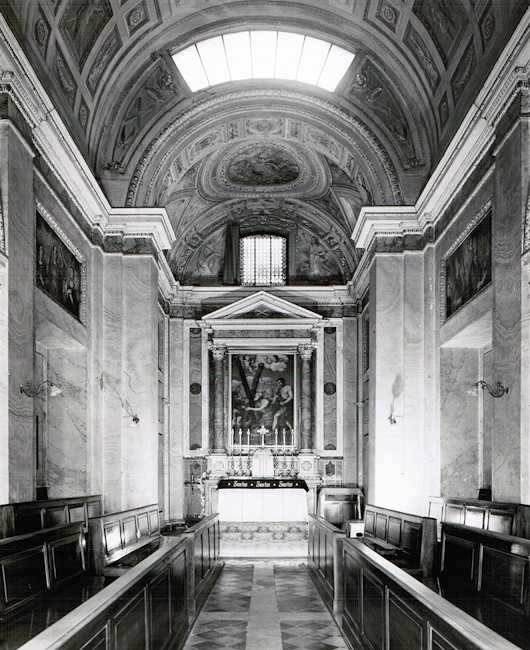2017 February
About Andrew Cusack
 Writer, web designer, etc.; born in New York; educated in Argentina, Scotland, and South Africa; now based in London.
Writer, web designer, etc.; born in New York; educated in Argentina, Scotland, and South Africa; now based in London. read more
News
Blogs
Reviews & Periodicals
Arts & Design
World
France
Mitteleuropa
Knickerbockers
Argentina
The Levant
Africa
Cape of Good Hope
Netherlands
Scandinavia
Québec
India
Muscovy
Germany
Academica
The Old Scots College
Via delle Quattro Fontane, Rome
Next month I’m off to Rome and the last time I was there I happened to walk past the old Scots College on the via delle Quattro Fontane. The Pontifical Scots College is probably the oldest Scottish institution abroad and certainly one of the most important, both historically and today. As Scotland’s primary seminary it has — almost literally — helped form the soul of the country, particularly during times of widespread persecution back in the mother country.
The church of Sant’Andrea degli Scozzesi (St Andrew of the Scots) was built in 1592 during the reign of Clement VIII, and early in the seventeenth century the church and neighbouring hospice were given over to the Scots College which had been founded a few years before. The seminary building itself was (I believe) built much later, in the nineteenth century after the college briefly ceased instruction due to the tumult of the French Revolution.
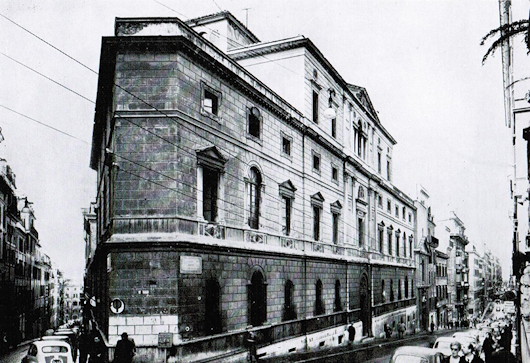
Sadly the building was not very well maintained and by 1960 it was falling apart. It was decided to sell the old college buildings in the Via delle Quattro Fontane and move to a larger site out the middle of nowhere in the Via Cassia. The move was made in 1964, and the Scots College has remained there ever since, while the old college housed a bank for many years and more recently a lawfirm.
South African VCs in the Russian Civil War
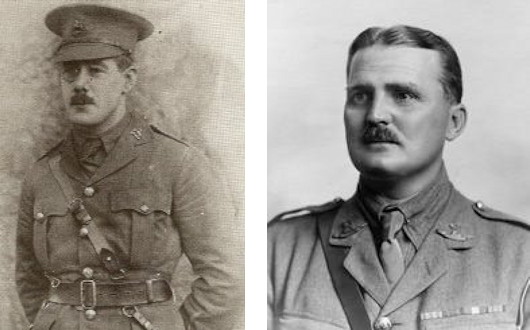
The South African contribution to the Russian Civil War is not very well known, nor particularly well researched by historians of the period. Several South African officers who found themselves in Europe by the time of the armistice ending the Great War volunteered to serve in Russia fighting the Bolsheviks — either with the Allied force there or with the White forces themselves.
Among the South African volunteers were two winners of the Victoria Cross — Major Oswald Reid (above, left) of Johannesburg, and Lt Col John Sherwood-Kelly (above, right) from the Eastern Cape.
The South African aviation pioneer K R van der Spuy — who ended up a major general — managed to serve from the early days of 1914 all through the First World War. His engine failed in Russia, however, and he was taken prisoner after a forced landing in Bolshevik-held territory. The Soviets released him from imprisonment in 1920.
As Cdr W M Bisset wrote elsewhere: “Despite the harshness of the Russian winter and the growing prowess of the Red Army, South African officers were able to make a valuable contribution to the operations of the Allied and White Armies which is well illustrated by the important posts which they held and the awards they received.”
Fillon: Which Right?
A Rémondian Analysis of the French Presidential Candidate
One of the most significant contributions of the historian and political scientist René Rémond was his theory regarding the tendencies of the French right wing. He contended that, broadly speaking, there are three right wings in France: legitimist, bonapartist, and orleanist. These terms are not bound by their historic use, but rather (Rémond argued) serve as useful guides to understanding French conservatism today.
Gaullism, for example, with both its populism and its reliance on the authority of a charismatic leader, is classified as bonapartist. Social conservatism, meanwhile, with its affinity for the Church and for tradition, comes in under legitimism. And economic liberalism — the bourgeois supremacy of the markets — is orleanist.
What to make of the current presidential candidate of the French right, M François Fillon? The Québécois website Dessinons les élections (“Let’s draw the elections”) sought to apply a Rémondian analysis of Monsieur Fillon in one of its weekly cartoons (by Frédéric Mérand & Anne-Laure Mahé).
Their conclusions are as follows:
Legitimism: 60%
– social conservatism
– Christian values
– order and traditionOrleanism: 30%
– economic liberalismBonapartism: 20%
– a sense of the State
– idea of the providential man with reference to de Gaulle
Of course, many now think that, due to the usual scandals, Fillon is yesterday’s man and that Macron is the man of the hour. The two are chalk and cheese. Fillon is the family man from the country, loves hunting, and clings to the values of the Church. Macron is a socialist énarque and investment banker who married one of his school teachers (twenty-four years his senior).
The elephant in the room: Madame Le Pen. The leader of the Front national will, there is almost no doubt, top the first round of the election but then, in the second round, will have to face whichever other candidate gains the next highest number of votes. Whoever that candidate is will almost certainly gain all the anti-frontiste votes and be propelled to victory and the Elysée.
At the moment, it looks like the second candidate will only have to win around 22 per cent of the vote in order to effectively gain the presidency. Such a low level of actual support is one of the things the 1962 changes to the constitution sought to prevent, but when faced with an FN candidate as in 2002 or (presumably) this year the two-round system fails to prevent this.
As usual, the conservatives are calling for change and the progressives arguing for stasis, but it remains to be seen which option France will choose.
The slums of the Louvre
We are so used to the now-familiar image of the palais du Louvre — with its central wing and flanking arms wide open to the Jardin des Tuileries — that it’s easy to forget just how recent a creation this ensemble is. The palace began as a square chateau expanding upon the site of the medieval citadel. The Tuileries it eventually stretched towards was then an entirely separate palace. In-between the Louvre and the Tuileries was a whole neighbourhood of buildings, streets, alleyways, and squares.
Henri IV built the grande galerie on the banks of the Seine connecting the Old Louvre to the Tuileries by 1610, but the Louvre we know today really only came together under Napoleon III in the 1850s.
Until that point, a slum was built right up to the walls of the Palace, and even within the old courtyard. Balzac, predicting that one day all this would be cleared, noted the slum with amusement as “one of those protests against common sense that Frenchmen love to make”. (more…)
An Hollandic Hovel
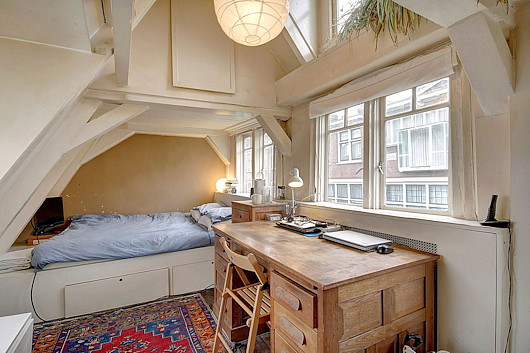
A friend sent this link to a property for sale in Amsterdam. I can easily imagine getting a lot of writing done while listening to LPs of baroque music (my latest craze) through a haze of cigarette smoke in a garret like this.
Its drawback is that it’s on an actual street — what’s the point of living in Amsterdam if you’re not on an actual canal?
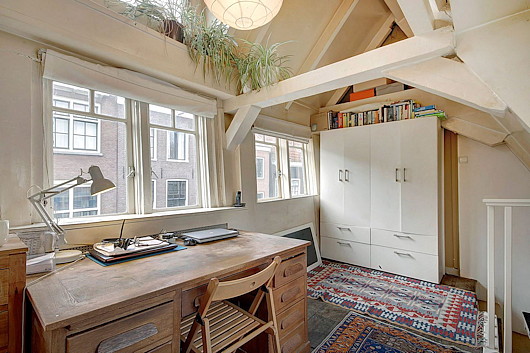
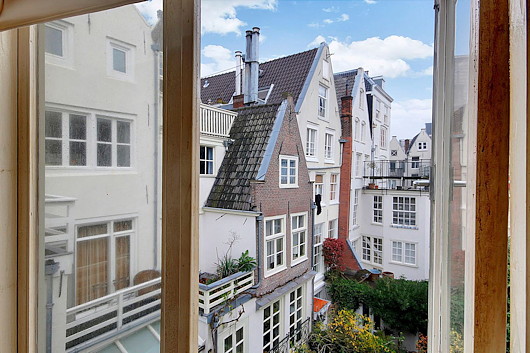
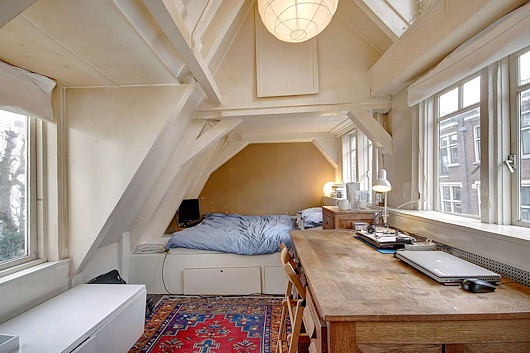
The Delarue Proposal for Parliament
Peers & MPs could still convene in the Palace during renovations
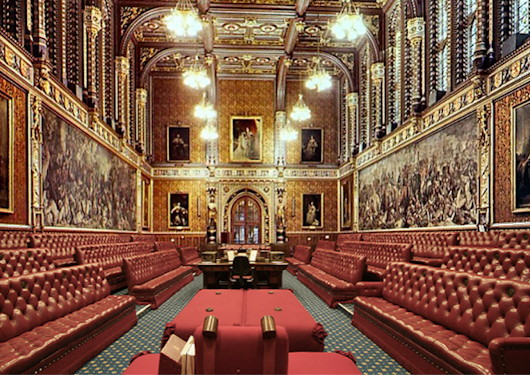
The Royal Gallery set up for temporary use as the House of Lords chamber
Credit: Anthony Delarue Associates
MPs are kicking up a fuss about the controversial proposals to shut down the entire Palace of Westminster for perhaps as long as eight or nine years. (Previously mentioned here.) The building is completely structurally sound, and on solid foundations, but the accumulation of mechanical, electrical, and technological systems over the course of the past 150 years has created a confused mess within the walls of the palace. Electrical lines compete with fibre-optic cables, telephone wires, not to mention various heating and cooling pipes, and even some lingering telegraph wires. No one’s quite sure what is what and all of it is getting older. Even just accessing it to figure out what to do requires taking the building apart — removing wood panelling, drilling through walls, etc.
Parliamentary authorities commissioned management consultants from Deloitte to come up with a number of options on how to tackle this problem, but in their Independent Options Appraisal they treated this merely as an ordinary engineering job, rather than recognising the Palace as one of the most important places in British history both medieval and modern and, importantly, one still in constant daily use.
The Joint Committee formed of members of both the Lords and Commons perhaps unsurprisingly endorsed the option Deloitte claimed was the quickest and cheapest: that the Lords, Commons, and everyone else be chucked out of the Palace entirely and that temporary accommodation be found nearby.
Further investigation by respected former minister Shailesh Vara MP suggested that Deloitte had failed to take into account that any VAT costs on this major project go back into the Treasury anyhow, and that there was a failure to account for the loss of revenue if the Lords are moved into the government-owned Queen Elizabeth II Conference Centre nearby. The QE2 is a profit-making venue popular with private clients, after all, and deploying it towards full-time legislative use will mean another significant loss for the Treasury. Meanwhile, in the courtyard of Richmond House on Whitehall, £59 million would be spent on building a new chamber for the House of Commons. This would be a permanent ‘legacy’ structure even though once the renovations to the Palace are complete there would be no use for it whatsoever.
The architect Anthony Delarue, having been taken on a tour of the Palace’s working underbelly by the engineers from the Restoration and Renewal programme, came up with an alternative proposal. Looking at the structure of the House of Lords chamber and the adjacent Royal Gallery, he realised that these two rooms could be maintained and occupied, with temporary services (electricity, heating, etc.) run from external sources. This would allow the renovation team to shut down the Palace’s systems entirely and re-do them completely, while the spaces in mind would still be able to be put to use. The Commons could then meet in the Lords chamber (as the wartime precedent suggested) and the Lords could meet in the Royal Gallery. Or indeed vice versa depending on the wishes of both Houses.
The advantages of this are no need for taking up the QE2 conference centre (with consequent loss of revenue for the Treasury) and no need to waste tens of millions on a temporary-but-permanent Commons chamber in the courtyard of Richmond House. In addition, both houses would be allowed to maintain their presence in the Palace of Westminster, in accommodation suitable to the traditions of the “Mother of Parliaments”.
Of course, the Restoration and Renewal programme ran a “high level review” of Delarue’s proposals and pooh-poohed the whole idea, amazingly claiming that it would probably cost £900 million more than the Deloitte option the Joint Committee preferred. Anthony Delarue has now written some comments responding to this review, pointing out that it relies on outrageously pessimistic estimates of timing, assumptions that are beyond the worst-case scenarios of project management.
MPs were expected to debate the matter last month, but the campaign organised by Sir Edward Leigh MP and Shailesh Vara MP has found considerable support among other Members of Parliament and it is believed the powers that be are looking for a delay. The Government have promised a free vote on the issue when it comes up for debate, which may very well be before the end of February.
● Anthony Delarue Proposal
● Deloitte Independent Options Appraisal
● Joint Committee Report
● High Level Review of Delarue Proposal
● Anthony Delarue Response to High Level Review
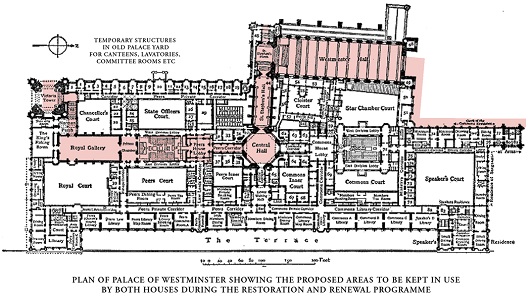
Credit: Anthony Delarue Associates
Holy Trinity Kingsway
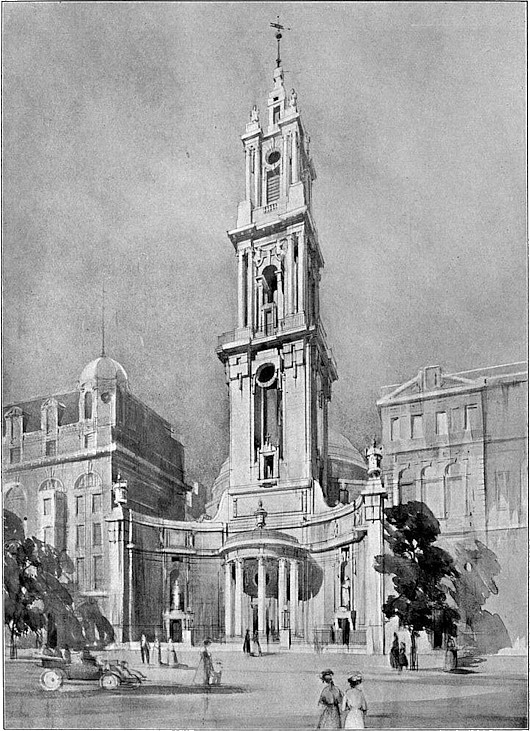
Holy Trinity, Kingsway
Not much information is available about this church. The architect was John Belcher but the ambitious tower was never built, nor was there much money to complete the interior.
After it was made redundant in the 1990s the church was demolished — except for the façade so obviously influenced by Santa Maria della Pace.
Search
Instagram: @andcusack
Click here for my Instagram photos.Most Recent Posts
- Silver Jubilee November 21, 2024
- Articles of Note: 11 November 2024 November 11, 2024
- Why do you read? November 5, 2024
- India November 4, 2024
- The Lithe Efficiency of the Old Constitution November 4, 2024
Most Recent Comments
Book Wishlist
Monthly Archives
Categories

